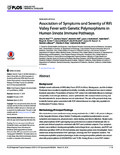Association of symptoms and severity of rift valley fever with genetic polymorphisms in human innate immune pathways
Abstract
Multiple recent outbreaks of Rift Valley Fever (RVF) in Africa, Madagascar, and the Arabian Peninsula have resulted in significant morbidity, mortality, and financial loss due to related livestock epizootics. Presentation of human RVF varies from mild febrile illness to meningo- encephalitis, hemorrhagic diathesis, and/or ophthalmitis with residual retinal scarring, but the determinants for severe disease are not understood. The aim of the present study was to identify human genes associated with RVF clinical disease in a high-risk population in Northeastern Province, Kenya.We conducted a cross-sectional survey among residents (N = 1,080; 1–85 yrs) in 6 villages in the Sangailu Division of Ijara District. Participants completed questionnaires on past symptoms and exposures, physical exam, vision testing, and blood collection. Single nucle-otide polymorphism (SNP) genotyping was performed on a subset of individuals who re-ported past clinical symptoms consistent with RVF and unrelated subjects. Four symptom clusters were defined: meningoencephalitis, hemorrhagic fever, eye disease, and RVF-not otherwise specified. SNPs in 46 viral sensing and response genes were investigated. Association was analyzed between SNP genotype, serology and RVF symptom clusters. The meningoencephalitis symptom phenotype cluster among seropositive patients was associated with polymorphisms in DDX58/RIG-I and TLR8. Having three or more RVF-related symptoms was significantly associated with polymorphisms in TICAM1/TRIF, MAVS, IFNAR1 and DDX58/RIG-I. SNPs significantly associated with eye disease included three different polymorphisms TLR8 and hemorrhagic fever symptoms associated with TLR3, TLR7, TLR8 and MyD88.Of the 46 SNPs tested, TLR3, TLR7, TLR8, MyD88, TRIF, MAVS, and RIG-I were repeatedly associated with severe symptomatology, suggesting that these genes may have a robust association with RVFV-associated clinical outcomes. Studies of these and related genetic polymorphisms are warranted to advance understanding of RVF pathogenesis.

